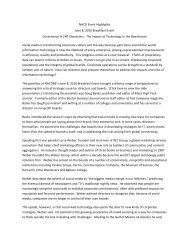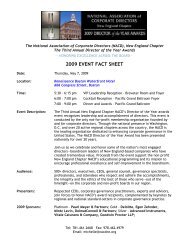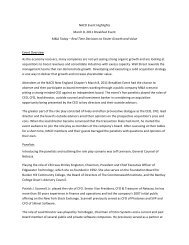IFRS: What should boards and audit committees be ... - IAS Plus
IFRS: What should boards and audit committees be ... - IAS Plus
IFRS: What should boards and audit committees be ... - IAS Plus
Create successful ePaper yourself
Turn your PDF publications into a flip-book with our unique Google optimized e-Paper software.
Employee BenefitsGeneral Requirements Potential Differences from U.S. GAAP••••••Primary st<strong>and</strong>ard – <strong>IAS</strong> 19Guidance addresses all forms of employee <strong>be</strong>nefits,including short-term <strong>be</strong>nefits; post-employment<strong>be</strong>nefits, (i.e., pensions); other long-term <strong>be</strong>nefits (i.e.,bonuses); <strong>and</strong> termination <strong>be</strong>nefitsAccounting for post-employment <strong>be</strong>nefits dependson the type of plan (defined contribution, defined<strong>be</strong>nefit or a multi-employer plan)Defined contribution plans involve payment of fixedamounts that are expensed as the employee providesservicesFor defined <strong>be</strong>nefit plans, a <strong>be</strong>nefit obligation isrecognized using an actuarial valuation method, netof plan assets heldTermination <strong>be</strong>nefits are recognized when“demonstrably committed”•••••••Multiemployer plans are accounted for based on theireconomic substance as either a defined <strong>be</strong>nefit ordefined contribution planPolicy choice regarding recognition of actuarialgains <strong>and</strong> losses; recognized in income either usingthe “corridor” method or accelerated method, orpermanently in equityPrior service costs are recognized immediately, if vestedMeasurement of expected rate of return on plan assetsis based solely on fair valueRecognition of a defined <strong>be</strong>nefit asset is subject to a“ceiling”Liability must <strong>be</strong> recognized for minimum fundingrequirements when obligation arisesTermination <strong>be</strong>nefits <strong>and</strong> curtailments are recognizedwhen “demonstrably committed”Implementation Considerations•••••Current plans will need to <strong>be</strong> evaluated to ensure they are accounted for under the appropriate type of planDetermining actuarial gains <strong>and</strong> losses requires judgmentProcesses <strong>and</strong> controls for the asset ceiling test will need to <strong>be</strong> developedData capture may <strong>be</strong> more detailed, which could lead to information system changesChanges in the timing <strong>and</strong> amount of pension cost may affect on income taxes• Changes pending: The <strong>IAS</strong>B has a project to significantly improve <strong>IAS</strong> 19 over the next couple of years <strong>and</strong> hasdivided the project into three phases in addition to a later more fundamental review in conjunction with the FASB ofaccounting for employee <strong>be</strong>nefits: (1) discount rate; (2) recognition <strong>and</strong> presentation of changes in defined <strong>be</strong>nefitobligation <strong>and</strong> plan assets <strong>and</strong> disclosures; <strong>and</strong> (3) contribution-based commitments. An ED was issued regarding thediscount rate for employee <strong>be</strong>nefits <strong>and</strong> the <strong>IAS</strong>B will determine the timing of the other phases in conjunction withthe financial statement presentation project.Key Questions to Ask•••How will the current accounting for employee <strong>be</strong>nefits <strong>be</strong> affected?Will the employee <strong>be</strong>nefit plan funding requirements <strong>be</strong> affected?Will future <strong>be</strong>nefit plan structures <strong>be</strong> affected?Share-based PaymentsGeneral Requirements Potential Differences from U.S. GAAP••••••Primary st<strong>and</strong>ard – <strong>IFRS</strong> 2Applies to transactions where goods <strong>and</strong> serviceshave <strong>be</strong>en exchanged for share-based paymentsTransactions generally measured based on a “grantdate” approachAccounting for grant depends on how transaction will<strong>be</strong> settled; cash settlement is a liability; equity settledis equity; may have elements of bothCompensation expense recognized on the basis ofgrant-date fair value over the period in which theshares vest Awards with “graded vesting” features aremeasured as multiple awardsNo specific valuation model is required to determineshare value; guidance requires inclusion of severalinputs•••••••Scope is broader; includes employee stock ownershipplansCompensation expense is recognized on an acceleratedbasis for grants with “graded vesting” provisionsCompensation expense related to certain types ofaward modifications is based on the higher of themodified award fair value or the original grant datefair valueMeasurement of compensation expense for grants tonon-employees is based on the fair value of the goodsor services when providedClassification of grant is based on how the transactionwill <strong>be</strong> settledIncome tax treatmentRequirements are the same for public <strong>and</strong> nonpublicentitiesImplementation Considerations••Processes <strong>and</strong> controls need to <strong>be</strong> developed for identifying all transactions that <strong>should</strong> <strong>be</strong> accounted for as sharebasedpaymentsAwards need to <strong>be</strong> evaluated for appropriate classification as a liability or equityJudgment will <strong>be</strong> required in the measurement of share-based payments at fair valueData capture may <strong>be</strong> more detailed, particularly regarding graded vesting, which could lead to information systemchangesIncome tax implications of share-based payments need to <strong>be</strong> understood• Changes pending: None•••Key Questions to Ask••••Should compensation structures <strong>be</strong> changed?How does accounting for existing share-based payment arrangements potentially change under <strong>IFRS</strong>?<strong>What</strong> fair-value techniques are <strong>be</strong>ing used <strong>and</strong> how will they change?Are the current information systems able to capture the information needed to account for share-based payments?<strong>IFRS</strong>: <strong>What</strong> <strong>should</strong> <strong>boards</strong> <strong>and</strong> <strong>audit</strong> <strong>committees</strong> <strong>be</strong> considering now? 17





